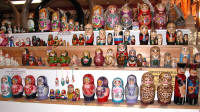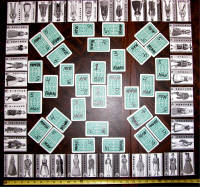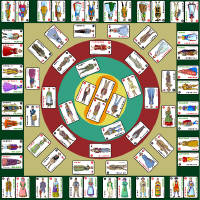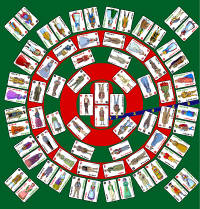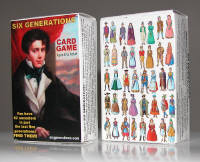
Six Generations Home Page >>> Reviews >>> Stepping Into History: The Genesis of a New Way of Playing Cards
Stepping Into History:
The Genesis of a New Way of Playing Cards
By Jonathan Albin
Fyodor Soloview had no idea that he would stumble onto such a revolutionary thought when he created his Six Generations card game in 2004.
Even as the world changed around him, he had no idea that he might embark on a course that could one day be seen as world-changing as the fall of the Berlin Wall, or that he might find himself up against as solid an opponent as the Iron Curtain was thought to be.
As a small boy in Moscow, Russia, Fyodor frequently visited his grandmother, and his cousins and others at numerous family gatherings. Inevitably at these get-togethers, decks of cards would be brought out, and the whole family would engage in playing many traditional card games. To us here in the states the game names are quaint, but games like Durak, Akulina, and Kings were family favorites. Soon, young Fyodor was, as he calls himself, “a card-minded boy.”
To a young Russian, though, the deck construction seemed… well... a bit Imperialistic. Named and Ranked Cards for nobility, and an almost anonymous image of the plainer numbered cards did not suit him at all...
At the same time, the young man became interested in genealogy… Family was a very strong influence on his life. The stories that the elder members of his family could recall and retell filled him with a sense of mystery and awe, and he developed a romantic penchant for collecting these stories. The challenges these ancestors faced, and the passion they expressed in their lives, brought the earlier generations to life in his developing mind. That influence of genealogy helped Fyodor greatly as he began to look at ways that he could make a move to selling products into the US marketplace.
In the 1990s, after he emigrated from Russia to the United States, Mr. Soloview started into business, involved in the sale of Russian souvenirs called Matryoshka, or nesting dolls, selling them to buyers directly during trade shows. In January 1999, he opened his own tiny gift shop and art gallery in Anchorage, Alaska, where Matryoshkas were one of the main items.
Parents would come to the shop to buy the Matryoshkas for their children to play with, and to enhance their appreciation for the nested dolls, Ted would embellish the sale, explaining about the purpose and history of those dolls.
Each of the dolls, nested within each other, represented another generation of the Russian people. Each subsequently tinier doll therefore stood for the next younger… the tiniest representing the babies of this generation. It is from this tiny solid wooden doll that the set gets its name. The larger the set, the longer the lineage backward in time, the greater the family dynasty.
That explanation satisfied the customers, but it opened the mind of Soloview even more. Each generation did not dress the same, so why did all the dolls look alike? At least there should be difference in dress, in facial features from generation to generation, shouldn’t there be?
His first endeavor was to research creating such dolls, with each subsequent generation in traditional dress for their era. Cost became a factor, because he was unsatisfied hiring low quality artists for such a project.
The project languished as his business in Anchorage foundered, as Big Box retailers like Wal-Mart and Fred Meyer capitalized on low cost and wide product range, and put him out of the retail business.
While considering the different ways in which he could move his genealogical doll idea into production, he stumbled upon the concept that would change his course, and put him into a toe to toe confrontation with standard card decks…
The Six Generations deck of 64 cards. Each of the cards depicts a male or female dressed in garb consistent with their nationality, and each with a given name that reflects a common name from their era and nation of origin. Only four cards represent contemporary characters, Jacob and Emily, brother and sister, and their parents – Michael and Jennifer. These contemporary characters are ranked as 1 and 2, being the current generations, and the other cards bear rankings reflecting the four prior generations.
In the original game, the oldest cards represent immigrants to the US… These rules are included in the game as printed, but a more updated and revised version of the rules is available from the company website, www.sixgenerations.com .
April 13th, 2007
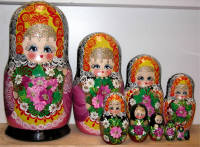
Evolution of designs of the board for the Six Generations card game.
2000 Gifts & Art, Soloview's store in the Dimond Center Mall, Anchorage, Alaska (1999-2004)
Display with Matryoshka-dolls.
Fyodor Soloview in the store, 2002.
Traditional set of Russian Matryoshka-doll.
Genealogical set of dolls with five generations of Russian women.
The final product - a deck with playing cards, called "Six Generations Card Game."
Manufactured in the USA by Carta Mundi USA in Sept. 2004.
ISBN 0-9760418-0-4.



